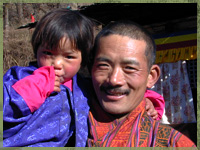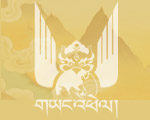
The Population
Buddhist traditions maintained within predominantly distanced
rural agrarian communities. Low levels of population density
and modernization contribute to small disparities of income
and little absolute poverty. Government is pursuing a people-centered
approach to development.
- Population: 650,000
- Population growth: 3.1%
- Nationality: Bhutanese
- Ethnic groups: Ngalop (Tibetan origin), Sharchop (Indo-Mongoloid
origin), Lhotsam (Nepali origin) (+ several indigenous tribes)
- Religions: Mahayana (Tibetan) Buddhist, Hindu
- Languages: Dzongkha, Nepali, English (+ numerous local
dialects)
- Settlement: 85% rural, 15% urban
- Capital: Thimphu (30,000-40,000 inhabitants)
- Infrastructure: health: 100% basic health coverage, education:
72% primary enrolment, electricity: 5% coverage, motor road:
3300kms, airport: 1
- UNDP Human Development Index: 0.510 (medium HD bracket)
GOVERNMENT
Traditional well-functioning system, linking a Buddhist monarchy
to multiple small village units. Although formal power is
currently centralized, the ongoing trend indicates a populist
approach to governance. Political focus on modernizing the
country whilst maintaining independence and stability.
- Government type: Monarchy
- Executive branch: Head of State: King Jigme Singye Wangchuck,
Cabinet of Ministers: elected by National Assembly for a
fixed five year period, Head of Government: on one year
rotation from the Cabinet, Royal Advisory Council: nominated
by the King
- Legislative branch: National Assembly - 150 seats: 105
elected from village constituencies, 10 represent religious
bodies, 35 designated by the monarch to represent government
and other secular interests
- Judicial branch: district and high courts, monarch is
the highest court of appeal, many disputes settled informally
through traditional institutions
- Administration: 7 Ministries, 5 Commissions, Police, Army,
Royal Bodyguard
- Administrative divisions: 20 districts (Dzongkhags), 196
blocks (Gewogs)
- Political parties: none
- Development interventions: 5 Year Plans - currently in
the eighth plan period, 1997-2002
ECONOMY
Significantly underdeveloped economy, owing to the country's
location at the periphery of world economic systems, a late
start to modernization and a subsequent cautious approach
to development. The majority of the population is engaged
in traditional subsistence-based agriculture. Major growth
prospects are hydropower, natural resource-based processing
and certain niche products (like tourism).
- Currency: Ngultrum (pegged with the Indian Rupee)
- Exchange rate: Nu46/US$
- GDP: US$ 4.2 billion p.a.
- GDP per capita: US$650, US$3900 (ppp)
- Inflation rate: 8%
- GDP composition by sector (1995): agriculture 38%, mining
and quarrying 1.3%, manufacturing 9.1%, electricity 8.3%,
construction 10.8%, trade 6 %, transport and communication
8.2%, financial services 9.5%, community and social services
10.9%, less imputed bank charges -2.1%
- Trade balance: Nu-2700 million p.a.
- Exported commodities: electricity, fruit, minerals
- Imported commodities: fuel, rice, machinery
- Budget: Nu3500 million p.a.
- Economic aid: India Nu900 million, donor recurrent financing
Nu350 million
|



